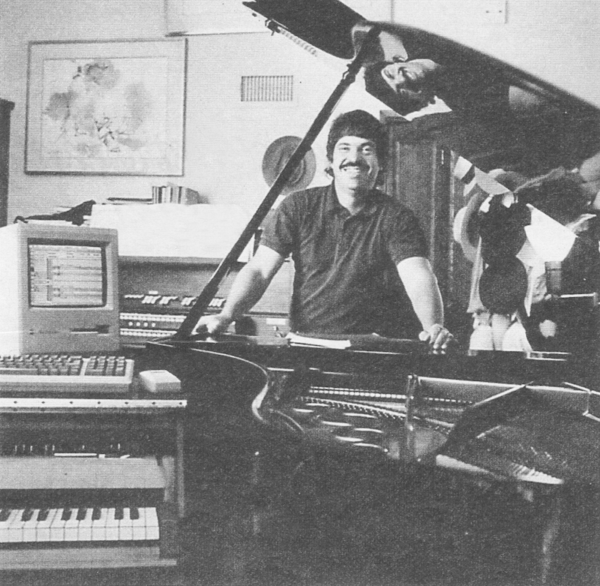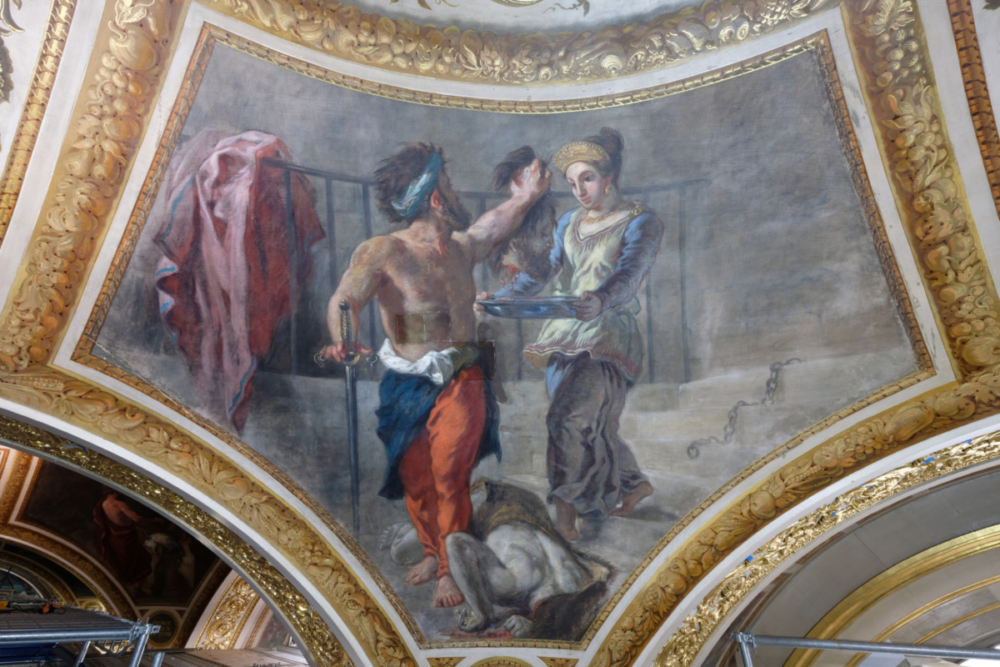IT WAS A SUNNY AFTERNOON in Los Angeles, and the researchers at Alan Kay’s computer lab were outside on the playground, shrieking their way through recess. Inside, in the art room of a rather down-at-the-heels elementary school in West Hollywood, a group of local technologists — people from the University of California at Los Angeles, the Rand Corporation, the International Business Machines Corporation, Pacific Telesis, the Times Mirror Company — were gathered around Formica-topped tables to hear Kay talk. A visionary scientist who has become a sort of Buckminster Fuller of personal computing, Kay was outlining his latest and most ambitious project.

Alan Kay at home in Los Angeles.
Kay heads a research team for Apple Computer Inc. that is devising technology that will allow children to draw their own animated plant-and-animal environment — their own vivarium, as he called it — on a personal computer. Looking like an overgrown child himself, with his tousled hair and old sweater, the 47-year-old Kay illustrated his talk with slides that showed scenes from the movie Bambi. “The vivarium environment we’re building is a very complex simulation,” he said, “and we want it to look like that.” Bambi seemed aglow with personality, the product of meticulously hand-drawn detail. “The only way we’re going to get that level of esthetic depth today is with a computer. So let me give you an example of how we’re approaching it. We decided we’d build 1,000 miles of Australian barrier reef and something to swim in it. Here’s how that turned out.”
He put on a videotape that showed computer-animated sharks swimming through a computer-animated ocean in search of computer-animated food. Merely to do this much in a convincing way had taken the equivalent of a dozen supercomputers, and yet, as Kay pointed out, the sharks still weren’t intelligent — someone had to program their actions.
What Kay was proposing was a future in which one child on a personal computer could do the kind of animation that now requires a dozen supercomputers, and also create characters that are “artificially intelligent” — able to do things without the child’s intervention. He was planning to realize that future here, with the kids’ help. And he was doing it with funds from Apple and the support of people like Marvin Minsky, the Massachusetts Institute of Technology computer scientist who is regarded as the dean of artificial intelligence.
Like Minsky, Kay is not an inventor but a theoretician, one of a small circle of scientists whose ideas have shaped the information age. Within this group he’s all but alone in his focus on the desktop personal computer.
In 1971, he set up a research team at the Xerox Corporation’s Palo Alto Research Center to investigate a future in which many people had personal computers as powerful as today’s Macintosh or IBM PC — the future that exists today. During the next decade, this team developed a number of features that have since, thanks to Apple’s Macintosh, become standard — simple, visual commands; versatile and sophisticated graphics; laser printing that yields print-shop quality results. But these were only byproducts of the stated goal — to find out if personal computers could be made so simple that ordinary youngsters could learn not just to use them but to program them to do what they wanted. And that, in turn, was only one step toward the realization of Kay’s true ambition.
In 1968, almost a decade before Apple was formed, he had conceived a truly personal computer. He calls it the Dynabook — a very powerful, very portable electronic device, no larger than a notebook and destined to become just as ubiquitous. The Dynabook would carry an encyclopedia of information inside its circuits and plug into readily available networks containing the sum of human knowledge. Anybody from grade school up would be able to program it to do whatever was wanted. And there’s no reason it would even have to be a book; it could just as well be a wristwatch, or woven into a T-shirt.
For Kay, the Dynabook has become a Holy Grail. It guided his research at Xerox and now guides people’s thinking throughout the industry: Toshiba reportedly has built a near-prototype, and many scientists regard its development as all but inevitable.
“Alan likes to stay about 10 or 15 years out ahead of the rest of us,” says John Sculley, Apple’s president, whose investment in Kay’s vision represents a major departure for a company that prides itself on innovative engineering but has never before supported the sort of blue-sky research that’s done at major academic and corporate labs. “If we can figure out where technology is going to be 10 or 15 years out, that makes it easy to look at what we’re doing now and say, ‘Does that make sense?’”
Kay can be quite blunt for a dreamer, and as he talked that day to the assembled technologists, who sat surrounded by the children’s crude drawings of cave paintings and tribal masks, he spoke of today’s technology as if considering the artifacts of a backward civilization. On the features his team developed at Xerox: “It’s surprising to me that they’re even interesting after 15 years.” On recent progress in artificial intelligence: “There’s nothing that comes close to doing what a fish can do, let alone a cat. The closest thing that artificial intelligence has been able to do so far is a termite.”
If the Dynabook is to meet people’s needs, it will have to be much more intelligent than that. That’s what brought him here, to the Open School in Los Angeles. His goal this time is to find out if grade-school pupils can program a personal computer with artificial intelligence. With the Vivarium Project, he figures they at least ought to reach the level of a fish.
THE PATHWAY THAT HAS brought Kay to this project — the path toward the electronic servant, the personalized digital companion, quasi-intelligent and easily reprogrammable — was started a quarter-century ago by a handful of idealistic young men with a vision of the computer as an extension of the human mind.
Computers at the time were as impersonal as it was possible to get — hulking number-crunchers programmed by stacks of laboriously punched cards and tended by an elite corps of intermediaries. The idea that they could form a symbiotic partnership with humans was first set forth by one J.C.R. Licklider, an experimental psychologist who in the early 1960’s set up a computer-science program at the Pentagon’s Defense Advanced Research Projects Agency, known as DARPA, the office that finances long-range scientific research for the military.
In 1966 Alan Kay, after having served in the Air Force, played guitar in several jazz bands and graduated from the University of Colorado, joined the close-knit community of DARPA-financed computer researchers as a graduate student at the University of Utah. He knew nothing about computers except what he had picked up as a journeyman programmer in the Air Force. He knew nothing about Utah either, but, after growing up in the East, he enjoyed the Rockies so much that he had decided to apply to every school above 4,000 feet that had a Ph.D. program in computer science. It turned out Utah was the only one. When he left, three years later, that kind of aimlessness was gone, replaced by his own version of what had come to be known as the “DARPA dream” — the Dynabook.
Kay’s conception of the Dynabook began with his search for a metaphor that would encompass the computer’s capabilities. The common metaphor for the room-sized, card-fed mainframe computers of the 1960’s was the Pennsylvania Railroad — an enormous, complex and utterly impersonal system that set its own schedules and expected its customers to hew to them. By contrast, a DARPA-financed group in California had rigged up a computer system with screens and keyboards and various other gizmos; it was difficult to learn, but so exhilarating to operate that initiates often likened it to piloting a jet plane through information space.
Meanwhile, at M.I.T., Seymour Papert was developing the computer language Logo, which for the first time enabled children to program computers. “When I saw Seymour’s stuff,” Kay told me as he sat in his office at M.I.T., where he teaches computer science in his spare time, “I thought, ‘The right metaphor is a pencil.’ Unlimited access is what’s important. And that same year came the invention of the flat-panel display” — a screen no thicker than a notebook. “As soon as I saw that, I realized that the computer need be no larger than the display. That idea became the Dynabook.”
In short order, Kay’s image of the computer had changed from a tool controlled by an authoritarian bureaucracy to one that was universally available. He said: “That’s when I realized that the computer was like paper, except with extensions into time and into other dimensions. Paper can hold the same kinds of marks that computers can. But it’s hard to have a piece of paper that can look at the marks and do what they say. All the newness of the computer comes from its dynamic qualities — that’s why I called it the Dynabook. The computer is a new kind of medium — Gutenberg has come and we haven’t recognized him yet.”
KAY HAD FLOWN IN THIS MORNING on the red-eye to meet with a student, and was booked on a return flight to Los Angeles at 5 P.M. As he answered questions in his office, he fielded a steady stream of calls for his office mate, Minksy, who was not in. Minsky is one of the founders of artificial intelligence, the field whose aim is to get computers to think — to learn, to understand, to conceptualize. His involvement in the Vivarium Project suggests how important artificial intelligence is to it.
Like most computer scientists, Kay thinks there will eventually be networks offering access to everything from the branch bank around the corner to a business meeting on the other side of the world and, to make use of them, he thinks people will need to equip their Dynabooks with artificially intelligent “agents” — little computer programs that will work these networks independently. Frankly, he figures that in a decade or so, the world will be so tangled up in networks that without these agents we would be helpless.
Kay’s agents would be our personal electronic servants, allowing us to get all the information out there without having to worry about how. The idea originated at M.I.T. in the 1950’s, but it didn’t go very far because nobody put in the sustained effort to bring it off. Several years ago, on a sabbatical at M.I.T., Kay envisioned two primitive agents: Newspeek, which browses data bases all night to assemble whatever kind of personal “newspaper” a user would like, and Phoneslave, a flexible answering machine that asks callers whatever you want asked. In 1985, after he started working for Apple, he decided to tackle the agent problem full time.
Meanwhile, he began thinking about working with children again, the way he had done at Xerox, when students at a Palo Alto junior high came up to the lab after school to program. This time he chose the Open School. The kids there don’t know it yet, but two years from now — if all goes according to plan — the fish they construct in their vivarium will turn into personal servants that run errands inside their computers.
AN ENTHUSIASTIC MAN with an eager, open face, Kay seems almost effervescent with ideas. But trying to pin him down about exactly what his vivarium is can be a little tricky. On one level, it’s a lab for investigating how to enable ordinary people to create their own agents. On another level, it’s an attempt to develop a curriculum that uses computer animation and artificial intelligence to enable children to understand animal societies by building their own society within the computer. And on still another, it’s an artificial-intelligence project that aims to build models of the thinking processes of animals. All these aspirations converge in the hoped-for result — getting children to build their own agent/fish.
The confusion arising from these overlapping ambitions leads to a vagueness that seems to suit Kay’s purposes. To understand why is to understand a crucial distinction between science and engineering: Engineers have to know what they’re building, but scientists don’t have to know what they’re looking for. “A good basic researcher will not be pinned down as to goals,” Kay said one afternoon as he sat in the Vivarium Project’s cluttered headquarters on Sunset Boulevard. “He’ll tell you directions, but not goals. Having goals says you already know what the answer is supposed to be.”
Kay left Xerox because the people in his group insisted on turning one of their ideas into a product rather than pushing ahead with new ideas. They had developed an easy-to-use programming language known as Smalltalk. “But I could not get them to stop working on the thing,” Kay said. “They wanted to get it out” and sell it. “It drove me crazy.” He paused for a moment. “I’d be a lot richer if I wanted to get things out.”
Thanks to the enthusiasm of Steven Jobs, the Apple co-founder who headed its Macintosh project, Apple was the first company to exploit successfully the work Kay’s team did at Xerox. In 1984, when Kay was chief scientist at the foundering Atari Corporation, Jobs lured him to Apple to generate ideas. “He’s the consummate technological bumblebee,” Jobs says today, “going around pollinating things.”
Kay had been at Apple a year when Jobs was forced out in a power struggle with John Sculley, the Pepsi-Cola executive he had brought in to head the company. Kay, who had just begun to conceptualize Vivarium, sat out the fireworks at a chamber-music camp in New Hampshire. After he returned, he started having long chats with Sculley, and by the end of 1985 Sculley had given him the go-ahead on Vivarium.
“Sculley got very interested in the process” Kay had used at Xerox, Kay explained. “He discovered that a lot of the ideas Xerox is famous for were spinoffs of much more grandiose things, like the Dynabook. Almost none of the stated goals were successful, but the spinoffs for Apple alone are bringing in more than a billion bucks a year.”
“Alan takes the orthogonal view, the unexpected view,” Sculley said later in his California-casual office at Apple headquarters in Silicon Valley. “He goes down a path and then he says, ‘Oh, gosh, I wonder what this would look like if you turned the world upside down?’ And he’s able to draw in experience from totally different disciplines and wonder what the implications would be for whatever he’s studying. To do that, you need to have a critical mass of knowledge in a wide range of fields, which Alan has, and the patterns of your neural transmitters have to be woven in such a way that you think the way he does. It’s almost a mutation.”
The orthogonal view: eventually you realize that the secret of Kay’s creativity is the 90-degree shift, his habit of coming in at right angles from the established pattern. It’s something not everyone can pull off.
Kay has a Ph.D. in computer science and bachelor’s degrees in mathematics and biology; he’s up on quantum and classical physics and on Western and Oriental philosophy; he’s well-versed in child cognition; and he’s passionately devoted to music, playing everything from jazz and rock guitar to Bach organ fugues.
His role in the Vivarium Project is that of the visionary who guides and shapes the endeavor. The staff consists of eight Apple employees led by Ann Marion, a young M.I.T. graduate. Their major achievement to date is software that gives the kids a “common area” onscreen — a corner in which whatever a child draws on one computer immediately appears on all the others.
This represents a significant advance in computer networking with obvious applications outside the classroom. It’s easy to imagine how an architecture concern might use such a product. But if Vivarium is to be successful, some insights of a more cosmic nature will have to occur. What sort of insights? “I don’t know,” Kay replied as he climbed into his battered Honda for the five-minute drive from the Vivarium office to the Open School. “It’s very hard to say, ‘Two years from now we will have invented the flying buttress and the vaulted arch,’ because if you can say those things, you don’t have to do the research.”
To help with the big ideas, Kay has assembled an eclectic community of minds. In addition to Minsky, his advisory board includes Frank Thomas, the Walt Disney animator who created Bambi; Jim Henson, creator of the Muppets; Tim Gallwey, author of The Inner Game of Tennis; Richard Wurman, founder of Access Press; and Stewart Brand, creator of the The Whole Earth Catalog. Some of the advisers have specific tasks: Brand and Wurman, for example, are building a database designed to resemble an underwater “cave of knowledge” the fish can swim into when they need to get information for the kids. This cave will transform the fish from animated characters to agents that will assemble information.
“The teachers have agreed to give an A to any composition a child can get a fish to put together,” Kay said, pulling up outside the school.
A racially and ethnically diverse public school drawing students from across Los Angeles, the Open School: Center for Individualization was set up 10 years ago at the insistence of white parents, professionals who wanted a democratic alternative to private school. Its educational methods are based on the precepts of the innovative and controversial psychologist Jerome Bruner. The emphasis is on personal exploration and discovery. Rather than sitting in rows of desks and receiving lessons in one subject after another, pupils work in small teams and learn their three R’s as part of a larger field of study — dinosaurs for the first- and second-graders, oceans for the third- and fourth-graders, and so forth.
The students’ attitude toward school differs dramatically from that of other grade-school pupils. Bells, for example, are often ignored. It’s time to go home! one teacher pleaded at 3 o’clock. Under her breath, she added, “This is the only school I know where you have to tell them when to leave.”
On the wall behind her was a one-sentence story a first-grader had written on a Macintosh: “I like my Tyrannosaurus Rex because he eats meat.” The computers in the room were almost lost amid heaps of paper.
“My style of research is to take a big adult question and to recast it as a children’s question,” Kay said as the children drew dinosaurs in defiance of the bell. “You design more carefully when you design for children. We all remember how ill-treated we were in school, so we try to make things nicer.”
Was Kay ill-treated in school? Certainly he had problems there. The intensely bookish son of an Australian physiologist and a Massachusetts artist and musician, he was better at reading and playing guitar and building gizmos than at sports and examinations. Clearly, one thing that appeals to him about Vivarium is the opportunity it offers to reshape the educational experience, especially as it involves computers. “Standard computer-aided instruction treats knowledge as a fluid that can be transferred from the teacher vessel into the empty student vessel,” he said. “A better system is one that gives the child an environment to explore.”
But is giving them a computer-based fantasy environment a good idea? Books have been written about people driven mad by the chance to play God in a computer-generated universe.
“The trick with all this stuff is to have both love and contempt for what you create,” Kay says. “Megalomania is not far away if you think everything you do is cosmic. All the children I’ve worked with treat this as an artistic thing — they want to share it. Most people share when they have something to talk about, and anything creative gives you something to talk about. Then the question is, suppose you have a disturbed child — is it worse for that child to be autistic or to be a nerd?”

 November 8, 1987
November 8, 1987





